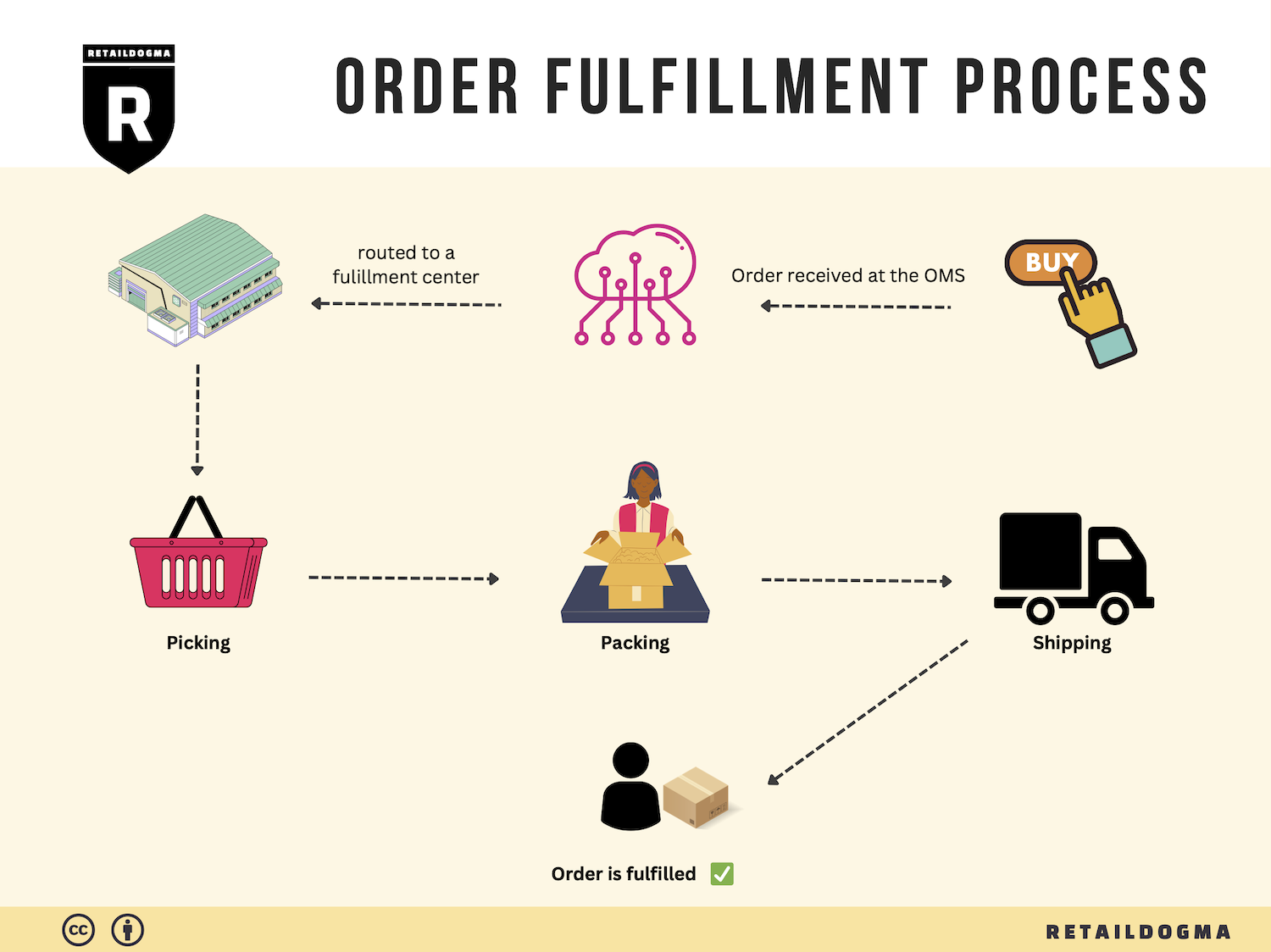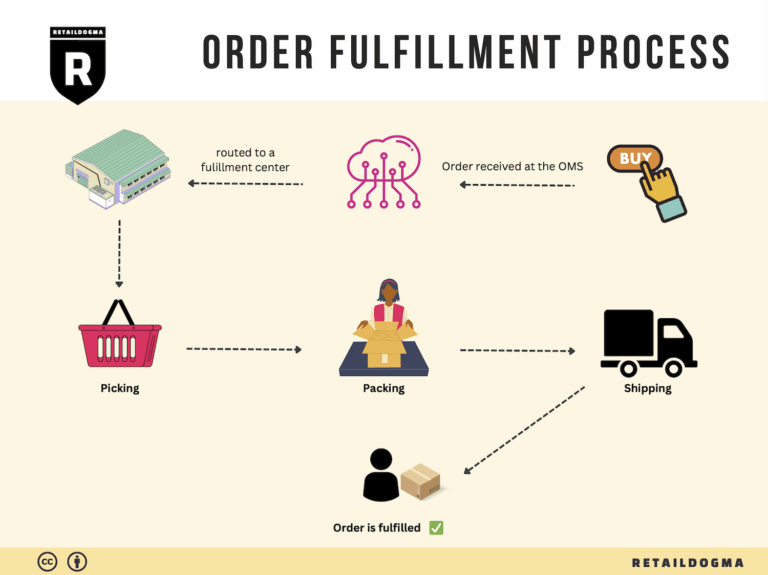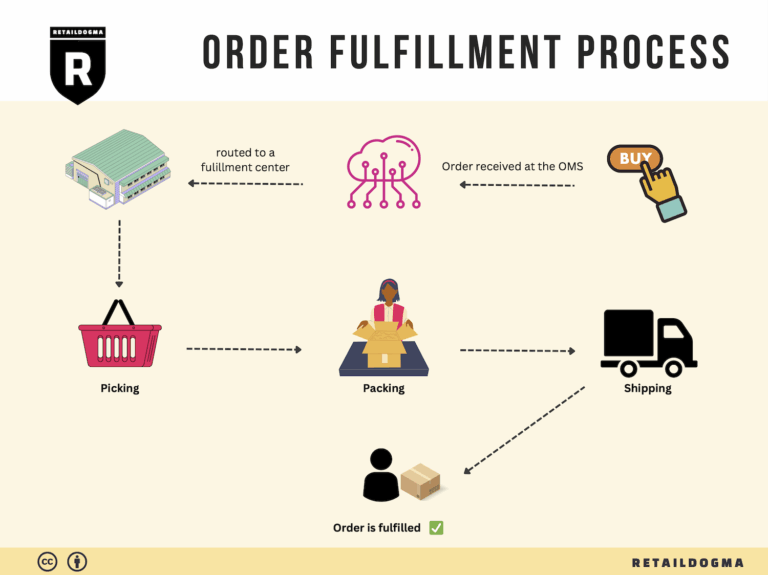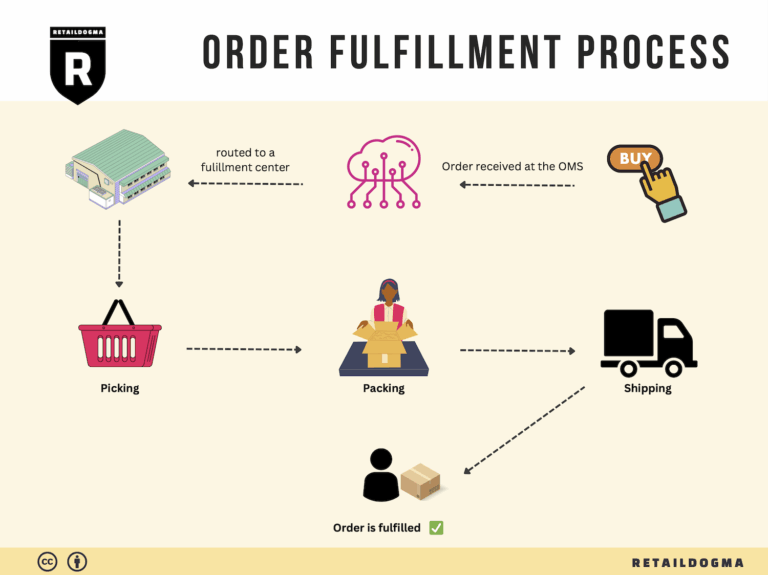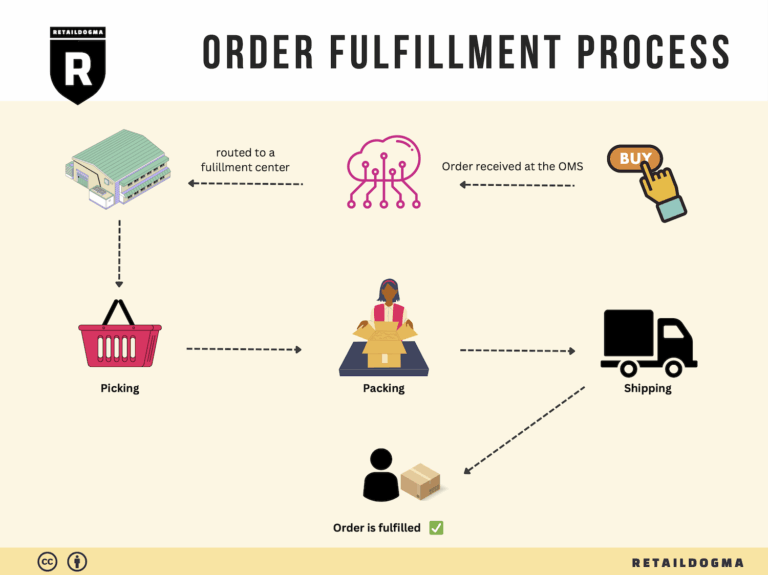How Order Fulfillment Works: A Step-by-Step Guide for Businesses
What is E-commerce Fulfillment? An Introduction for Growing Businesses
Understanding the Fulfillment Process
As an e-commerce business owner, you may find yourself grappling with the overwhelming tasks of packing and shipping orders, especially during peak sales periods. This common pain point can distract you from focusing on what truly matters: growing your business. Fulfillment, in its simplest form, is the process of getting a product into the hands of your customer. It encompasses everything from inventory management and order processing to packing and shipping.
The Importance of Fulfillment in E-Commerce
Effective fulfillment is crucial for enhancing customer satisfaction and driving repeat purchases. A streamlined fulfillment process can mean the difference between a satisfied customer who becomes a loyal brand advocate and one who abandons your store for a competitor. The complexities of fulfillment increase as your business scales, making it vital to explore various models and strategies that can help you manage these logistics efficiently.
What This Guide Will Cover
In this guide, we will delve into the different fulfillment models available to growing businesses, including Third-Party Logistics (3PL) and Fulfilled by Amazon (FBA). We will break down the core services associated with each model, such as inventory storage, order picking, packing, shipping, and returns management. Understanding these services is essential for making informed decisions about which model best suits your business needs.
Moreover, we will provide practical insights on how to choose the right fulfillment partner. Factors to consider include service offerings, technology integration, scalability, and pricing. Knowing what questions to ask potential partners will empower you to find the best fit for your operations.
Navigating the Pricing Landscape
Pricing is another critical aspect of fulfillment that we will address. We’ll explore the various cost structures associated with different fulfillment models, helping you understand how to budget effectively and avoid hidden fees that could impact your bottom line.
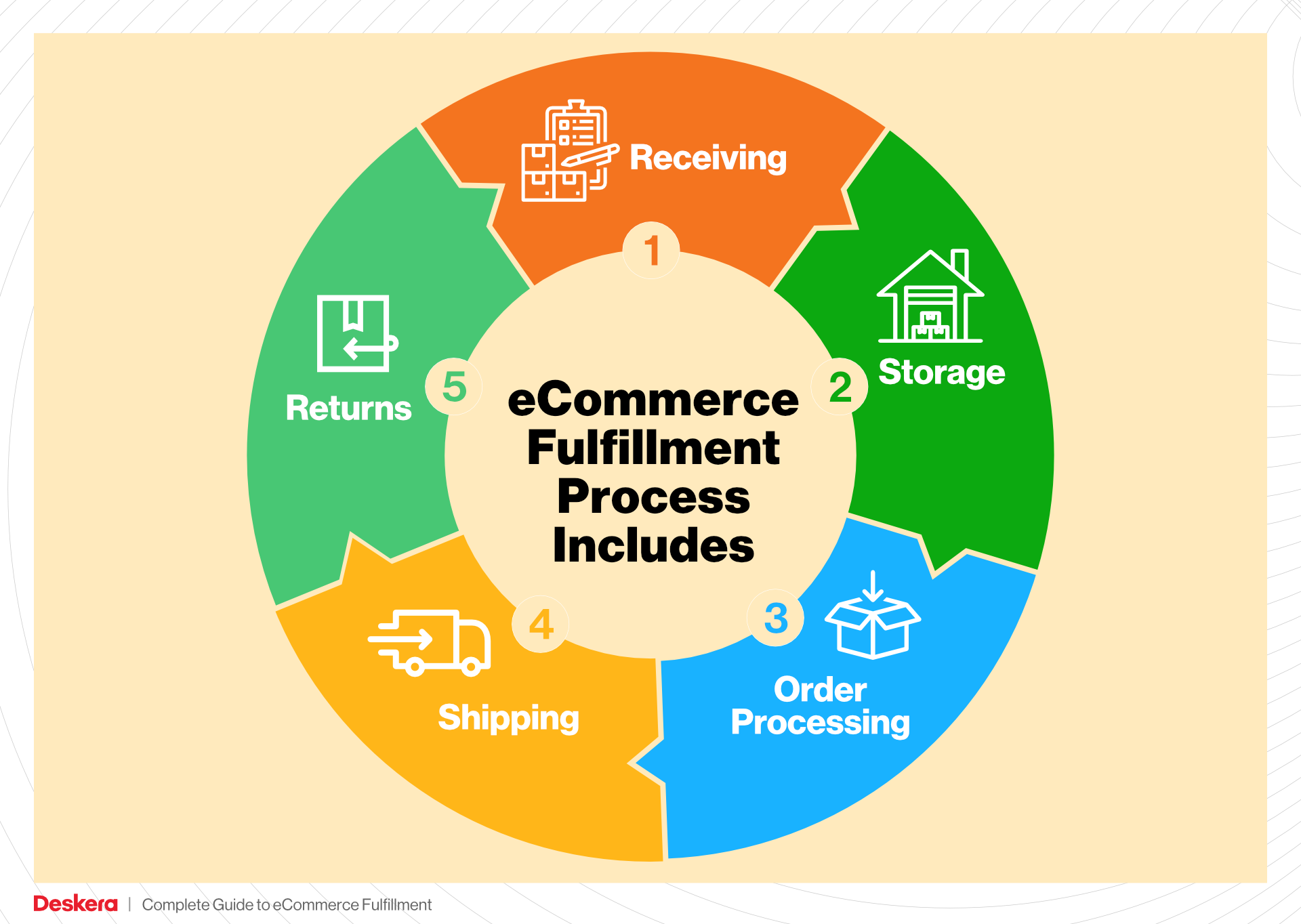
Empowering Smart Decisions
Ultimately, this guide aims to empower you, the e-commerce business owner, with the knowledge and tools needed to make smart logistics decisions. By understanding the nuances of fulfillment, you can not only streamline your operations but also enhance the overall customer experience, paving the way for sustainable growth and success in the competitive e-commerce landscape.
What You’ll Learn In This Guide
- What is E-commerce Fulfillment? An Introduction for Growing Businesses
- The Order Fulfillment Process: From ‘Buy’ Button to Customer’s Door
- Comparing Fulfillment Models: In-House vs. 3PL vs. Dropshipping
- A Deep Dive into Amazon FBA: Pros, Cons, and Who It’s For
- Core Services Offered by Fulfillment Centers
- How to Choose a Fulfillment Partner: A 6-Point Checklist
- Understanding Fulfillment Pricing: A Breakdown of Common Fees
- Frequently Asked Questions (FAQs) about Fulfillment
- Conclusion: Is Outsourcing Fulfillment the Right Move for Your Business?
- Important Disclaimer
The Order Fulfillment Process: From ‘Buy’ Button to Customer’s Door
1. Receiving Inventory
The first step in the order fulfillment process is receiving inventory. This involves the delivery of products to the fulfillment center, where they are checked against the purchase orders to ensure accuracy. Each item is assigned a Stock Keeping Unit (SKU) to facilitate tracking and management.
Importance: Accurate receiving is crucial as it lays the foundation for effective inventory management. Discrepancies at this stage can lead to stockouts or overstock situations, which can negatively impact customer satisfaction and operational efficiency. By implementing rigorous checks and maintaining accurate records, businesses can reduce errors and streamline the subsequent steps in the fulfillment process.
2. Warehouse Storage
Once the inventory is received and verified, it is organized and stored in the warehouse. This involves assigning specific locations to each SKU within the storage system, whether that be shelving, bins, or pallets. The use of warehouse management systems (WMS) can facilitate this process by optimizing storage space and improving accessibility.
Importance: Efficient warehouse storage is essential for quick order retrieval. An organized warehouse minimizes the time employees spend locating items, which directly affects the overall speed of order fulfillment. Moreover, proper storage techniques can help prevent damage to products, ensuring that they remain in sellable condition.
3. Order Picking
When a customer places an order, the next step is order picking. This involves retrieving the correct items from their designated storage locations based on a pick list. A pick list is generated from the order details, providing information about which SKUs to collect and their respective quantities.
Importance: The accuracy and efficiency of the picking process are vital for customer satisfaction. Incorrectly picked items can lead to returns, refunds, and diminished trust in the brand. Implementing technologies such as barcode scanners or RFID can enhance picking accuracy and speed, allowing businesses to fulfill orders rapidly and reliably.
4. Order Packing
Once the items are picked, they move to the packing stage. This step involves securely packaging the products to ensure they arrive at the customer’s doorstep in perfect condition. Proper packing materials—such as bubble wrap, packing peanuts, and sturdy boxes—are essential for protecting the items during transit.
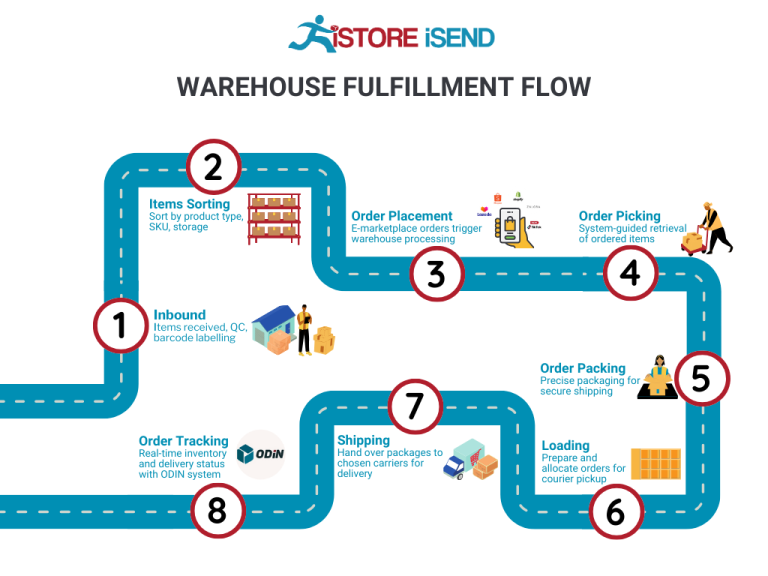
Importance: Effective packing not only safeguards products but also reflects the brand’s commitment to quality. An aesthetically pleasing and well-packed order can enhance the unboxing experience for customers, fostering loyalty and encouraging repeat business. Furthermore, efficient packing minimizes shipping costs by reducing the weight and size of the packages, which can lead to lower shipping fees.
5. Shipping & Delivery
The final step in the order fulfillment process is shipping and delivery. Once packed, orders are labeled and handed over to shipping carriers. Businesses often collaborate with multiple carriers to provide various shipping options, ensuring timely delivery to customers. Real-time tracking systems can also be implemented to keep customers informed about their order status.
Importance: Timely and reliable shipping is a cornerstone of customer satisfaction in e-commerce. Fast delivery options, such as same-day or next-day shipping, can give businesses a competitive edge. Moreover, providing tracking information enhances transparency and builds trust with customers, as they can monitor their order from the moment it leaves the warehouse to when it arrives at their door.
In conclusion, mastering each step of the order fulfillment process—from receiving inventory to shipping and delivery—is essential for e-commerce success. By focusing on efficiency, accuracy, and customer experience, businesses can scale operations effectively while maintaining high levels of customer satisfaction.
Comparing Fulfillment Models: In-House vs. 3PL vs. Dropshipping
Fulfillment Model Comparison
| Model | Who Handles Inventory | Best For (Business Stage) | Key Advantage | Key Disadvantage |
|---|---|---|---|---|
| In-House Fulfillment | The business itself | Established businesses with stable demand | Complete control over inventory and operations | High overhead costs and resource-intensive |
| Third-Party Logistics (3PL) | A third-party logistics provider | Growing businesses and startups | Scalable solutions with reduced overhead | Less control over operations and potential communication issues |
| Dropshipping | Supplier or manufacturer | New businesses and entrepreneurs | Low upfront investment and no inventory management | Lower profit margins and dependency on suppliers |
In-House Fulfillment
In-house fulfillment involves managing all aspects of inventory and order processing internally within the business. This model is often utilized by established businesses with stable demand and the resources to handle logistics. One of the key advantages of in-house fulfillment is the complete control it offers over inventory management, order processing, and customer service. Businesses can customize their processes, enhance quality control, and respond swiftly to customer inquiries. However, this model comes with significant disadvantages, including high overhead costs associated with warehousing, staffing, and technology investments. Additionally, managing logistics can be resource-intensive, taking focus away from core business activities such as product development and marketing. As a result, while in-house fulfillment can provide a robust operational framework, it may not be sustainable for businesses looking to scale efficiently.
Third-Party Logistics (3PL)
Third-party logistics (3PL) providers, such as Amazon Fulfillment Centers, handle the warehousing, order picking, packing, and shipping on behalf of businesses. This model is particularly beneficial for growing businesses and startups that may not have the infrastructure or resources to manage logistics effectively. One of the primary advantages of partnering with a 3PL is scalability; businesses can easily adjust their logistics operations to accommodate seasonal demand fluctuations without incurring the overhead costs associated with in-house fulfillment. Furthermore, 3PL providers often have established relationships with shipping carriers, allowing businesses to benefit from reduced shipping rates. However, a notable disadvantage is the potential loss of control over logistics operations, which can lead to communication issues or delays if not managed properly. Businesses must choose a 3PL partner that aligns with their operational goals to mitigate these risks.
Dropshipping
Dropshipping is a fulfillment model where the retailer does not hold any inventory but instead relies on suppliers or manufacturers to fulfill orders directly to customers. This model is particularly appealing for new businesses and entrepreneurs who want to enter the e-commerce space with minimal upfront investment. The primary advantage of dropshipping is the elimination of inventory management and warehousing responsibilities, allowing business owners to focus on marketing and sales. Additionally, it offers a wide range of product options without the financial risk associated with unsold inventory. However, dropshipping comes with its own set of challenges. Profit margins can be significantly lower compared to traditional retail models, as the retailer must rely on suppliers for pricing and fulfillment. Moreover, businesses are often dependent on the reliability of their suppliers, which can lead to issues with product quality, shipping times, and customer satisfaction. Therefore, while dropshipping offers a low-risk entry point into e-commerce, it requires careful supplier selection and management to ensure long-term success.
Conclusion
Choosing the right fulfillment model is crucial for the success of an e-commerce business. Each model—In-House Fulfillment, Third-Party Logistics, and Dropshipping—offers distinct advantages and disadvantages that should align with the specific needs and growth stage of the business. In-house fulfillment provides control but can be resource-intensive, 3PL offers scalability with reduced overhead, and dropshipping presents a low-risk entry but comes with challenges in profitability and supplier dependence. Business owners must carefully evaluate their operational capabilities, financial resources, and customer expectations when selecting a fulfillment strategy to ensure they can effectively scale their logistics and meet market demands.
A Deep Dive into Amazon FBA: Pros, Cons, and Who It’s For
Understanding Fulfillment by Amazon (FBA)
Fulfillment by Amazon (FBA) is a service provided by Amazon that allows businesses to store their products in Amazon’s fulfillment centers. Once a customer places an order, Amazon takes care of the picking, packing, shipping, and even customer service for those products. This model offers a seamless and efficient solution for e-commerce businesses looking to scale their operations without the logistical burdens that typically come with order fulfillment.
How FBA Works
-
Product Preparation: Sellers prepare their products according to Amazon’s guidelines, which may include packaging and labeling requirements.
-
Shipping to Fulfillment Centers: Sellers ship their products directly to Amazon’s designated fulfillment centers. Amazon has numerous centers strategically located across the country, including major hubs like Houston, TX, facilitating quicker delivery times.
-
Storage: Once received, products are stored in Amazon’s warehouses until sold. Amazon manages the inventory, ensuring that items are organized and easily accessible.
-
Order Fulfillment: When a customer places an order, Amazon’s systems automatically pick the product from the warehouse, pack it, and ship it directly to the customer. This process is typically very fast, often resulting in same-day or next-day delivery for Prime members.
-
Customer Service and Returns: Amazon also handles customer service inquiries and returns for FBA products, relieving sellers of these responsibilities.
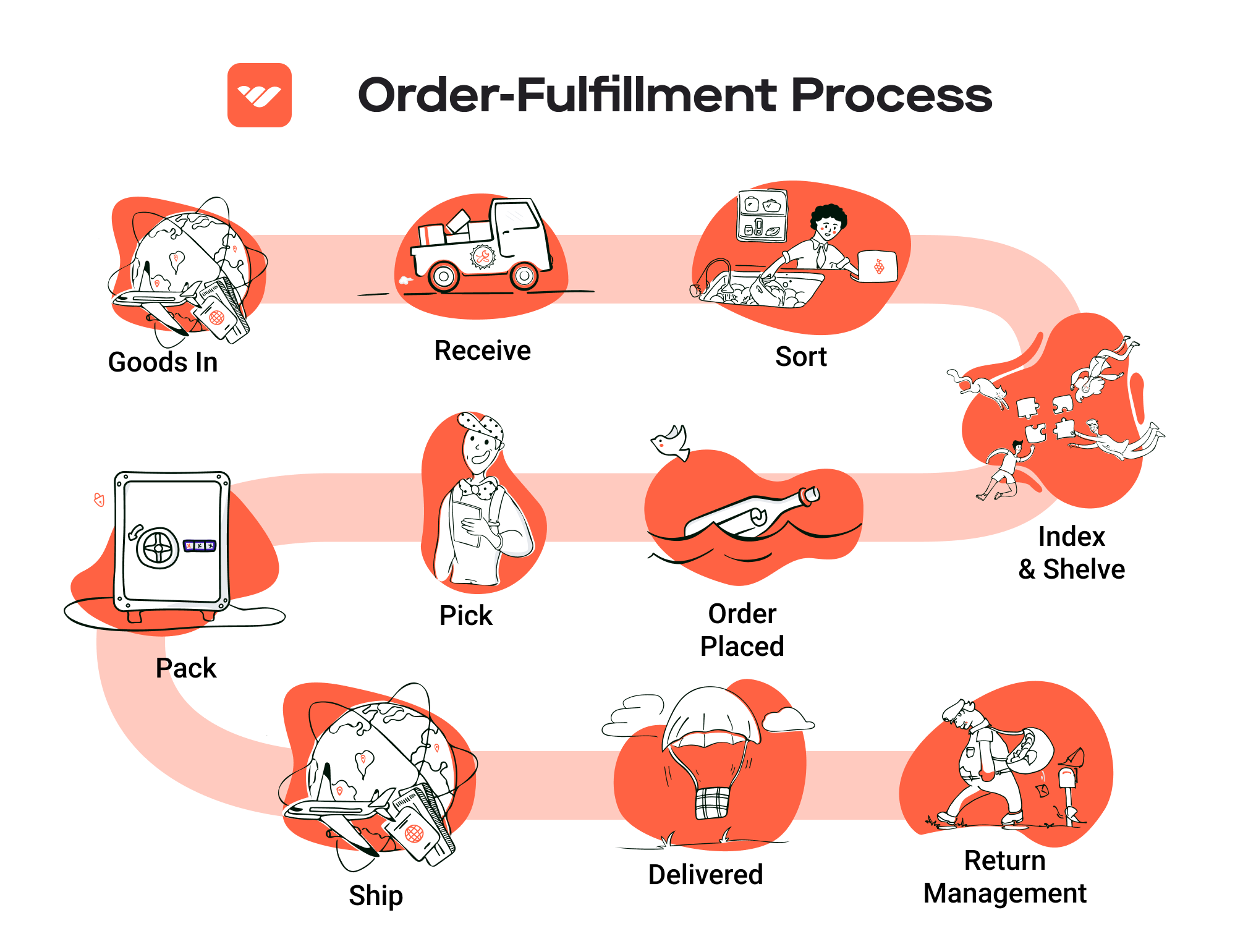
Pros of Using Amazon FBA
-
Prime Eligibility: Products fulfilled by Amazon are eligible for Amazon Prime, which significantly enhances visibility and sales potential. Prime members are more likely to purchase items that offer fast, free shipping.
-
Customer Trust: Leveraging Amazon’s brand can enhance customer trust. Consumers are more likely to purchase from sellers that utilize FBA due to Amazon’s reputation for reliability and customer service.
-
Multi-Channel Fulfillment: FBA allows sellers to fulfill orders from other sales channels (like eBay, Shopify, etc.) using Amazon’s infrastructure. This means businesses can manage inventory and shipping from multiple platforms without the need for separate logistics systems.
-
Scalability: FBA enables businesses to scale operations quickly. As order volumes increase, sellers can rely on Amazon’s resources to manage fulfillment without needing to invest in additional infrastructure.
-
Time Savings: By outsourcing fulfillment to Amazon, sellers can focus on other critical aspects of their business, such as product development and marketing, rather than logistics.
Cons of Using Amazon FBA
-
High Fees: While FBA can be advantageous, it comes with various fees, including storage fees, fulfillment fees, and additional charges for long-term storage. These costs can add up and eat into profit margins.
-
Strict Inventory Rules: Amazon has stringent inventory management rules that sellers must adhere to. Non-compliance can lead to penalties, including the removal of listings or inventory limits.
-
Commingling Risks: FBA uses a commingling system where products from different sellers are stored together. This can pose risks such as misdeliveries or issues with counterfeit goods, which can negatively impact a seller’s reputation.
-
Limited Control: When using FBA, sellers relinquish a significant amount of control over the fulfillment process, including packaging, branding, and shipping methods. This can affect the overall customer experience and brand perception.
-
Inventory Management Challenges: Managing inventory levels can be complex, particularly if sellers utilize multiple sales channels. Overestimating demand can lead to high storage fees, while underestimating can result in stockouts and lost sales.
Who is FBA Best For?
FBA is particularly well-suited for:
-
Small to Medium-Sized Businesses: Companies looking to scale their operations without the overhead of managing their own warehousing and logistics can benefit greatly from FBA.
-
E-commerce Entrepreneurs: New sellers entering the e-commerce space can leverage Amazon’s infrastructure to launch their products quickly without upfront investments in fulfillment.
-
Retailers with Seasonal Products: Businesses that experience fluctuations in demand can utilize FBA to manage peak seasons effectively without committing to long-term storage solutions.
-
Brands Seeking Wider Reach: Companies looking to enhance their visibility and credibility in the marketplace can benefit from the trust associated with Amazon, especially when targeting Prime members.
-
Multi-Channel Sellers: Retailers who sell across various platforms and want a streamlined fulfillment process will find FBA’s multi-channel fulfillment capabilities invaluable.
In summary, Fulfillment by Amazon offers significant advantages for businesses looking to optimize their e-commerce operations. However, it is essential to weigh these benefits against the potential drawbacks to determine if FBA aligns with your business goals and operational needs.
Core Services Offered by Fulfillment Centers
Inventory Management & Warehousing
Effective inventory management and warehousing are foundational elements of any successful e-commerce operation. Fulfillment centers provide businesses with the infrastructure needed to store products safely and efficiently. This service involves not just the physical storage of goods but also the organization and tracking of inventory levels.
The primary benefit of partnering with a fulfillment center for inventory management is the ability to optimize stock levels. By utilizing advanced inventory management systems, fulfillment centers can monitor stock in real-time, alerting businesses when it’s time to reorder or when certain items are running low. This minimizes the risk of stockouts, which can lead to lost sales and dissatisfied customers. Additionally, efficient warehousing practices help reduce overhead costs associated with maintaining an in-house storage facility, freeing up capital that can be reinvested into other areas of the business.
Furthermore, fulfillment centers often employ climate-controlled environments and specialized storage options to accommodate diverse product types, ensuring that items are stored under optimal conditions. This is particularly important for businesses dealing with sensitive products, such as electronics or perishables, where the integrity of the item is paramount.
Pick and Pack Services
Pick and pack services are critical to the fulfillment process, ensuring that customer orders are accurately assembled and prepared for shipment. When an order is placed, fulfillment center staff utilize a systematic approach to “pick” the items from their designated storage locations. Once all items are gathered, they are then “packed” securely for shipment.
The advantages of efficient pick and pack services are manifold. First and foremost, they ensure speed and accuracy in order fulfillment. With trained staff and sophisticated systems in place, fulfillment centers can process orders quickly, which is essential for maintaining high customer satisfaction levels. Fast shipping is a key differentiator in e-commerce, and efficient pick and pack operations help businesses meet or exceed customer expectations.
Moreover, fulfillment centers often implement quality control measures during the packing process to reduce the likelihood of errors. This means that businesses can trust that their customers will receive the correct items in good condition, which is crucial for building brand loyalty. Additionally, fulfillment centers can offer customized packing options, such as branded packaging or gift wrapping, which can enhance the customer experience and add value to the product offering.
Kitting and Assembly
Kitting and assembly services provide businesses with the ability to bundle multiple products together into a single package, creating a cohesive unit that can be marketed as a complete solution. This service is particularly useful for businesses that sell products that naturally complement one another, such as kitchen gadgets or home improvement items.
The benefits of kitting and assembly are significant. First, this service allows businesses to streamline their inventory by reducing the number of individual SKUs they need to manage. Instead of tracking multiple products, businesses can offer a single bundled product, simplifying the sales process and inventory management.
Additionally, kitting enhances the customer experience by providing convenience. Customers appreciate the ease of purchasing a complete set of items rather than having to buy each one separately. This not only improves sales potential but also encourages higher average order values, as customers are more likely to purchase bundled products.
Furthermore, fulfillment centers equipped for assembly can handle complex requirements, such as adding custom labels or packaging, which can be crucial for maintaining brand identity. By outsourcing kitting and assembly, businesses can focus on their core operations while benefiting from the expertise and efficiency of the fulfillment center.
Returns Management (Reverse Logistics)
Returns management, or reverse logistics, is an often-overlooked yet vital service offered by fulfillment centers. In the e-commerce landscape, where return rates can be significantly higher than in traditional retail, having a robust process for handling returns is essential for maintaining customer satisfaction and loyalty.
Fulfillment centers streamline the returns process by providing clear guidelines for customers on how to return products. They manage the entire reverse logistics process, from receiving returned items to inspecting their condition and restocking them as needed. This efficiency not only speeds up the returns process but also ensures that businesses can quickly restock and resell items that are still in good condition.
The primary benefit of effective returns management is the enhancement of customer trust. A hassle-free return process encourages customers to make purchases with confidence, knowing that they can easily return items if necessary. This can lead to increased sales and repeat business, as customers are more likely to shop from a retailer that offers a straightforward returns policy.
Moreover, fulfillment centers can provide valuable insights into return trends and reasons, allowing businesses to identify patterns and address potential issues with products or customer expectations. By analyzing return data, businesses can make informed decisions about product quality, marketing strategies, and customer service enhancements, ultimately leading to improved overall performance.
In conclusion, partnering with a fulfillment center for these core services—inventory management and warehousing, pick and pack services, kitting and assembly, and returns management—can significantly enhance the operational efficiency of e-commerce businesses. These services not only streamline logistics but also contribute to a positive customer experience, paving the way for sustainable growth and success in the competitive online marketplace.
How to Choose a Fulfillment Partner: A 6-Point Checklist
Location & Warehouse Network
Importance:
The geographical location of your fulfillment partner is crucial for ensuring timely deliveries and reducing shipping costs. A fulfillment center located near your target market can significantly enhance your customer satisfaction through faster shipping times, especially for businesses relying on express services.
Questions to Ask:
– Where are the fulfillment centers located, and how does this align with our customer base?
– What is the average shipping time to key markets?
– Do you have multiple locations to support nationwide or international shipping?
– How do you handle distribution during peak seasons, and are additional locations utilized?
Technology & Integrations
Importance:
In today’s e-commerce landscape, robust technology is essential for seamless operations. A good fulfillment partner should offer advanced technology that integrates well with your existing systems (e.g., e-commerce platforms, inventory management software). This integration ensures real-time tracking, inventory management, and order processing efficiency.
Questions to Ask:
– What technology platforms do you use for order management and tracking?
– Can your system integrate with our existing software (e.g., Shopify, WooCommerce)?
– How do you manage inventory updates, and how frequently is this information provided?
– Do you offer real-time analytics and reporting capabilities?
Specializations (e.g., Cold Storage, Oversized Items)
Importance:
Depending on your product offerings, you may require specialized fulfillment services, such as cold storage for perishable goods or handling oversized items. Ensuring that your fulfillment partner has the expertise and facilities to accommodate these needs can prevent costly mistakes and delays.
Questions to Ask:
– What types of specialized storage do you provide (e.g., cold storage, climate control)?
– How do you handle fragile or oversized items?
– Do you have experience in fulfilling products similar to ours?
– What quality control measures do you implement for specialized items?
Scalability & Capacity
Importance:
As your business grows, your fulfillment needs will evolve. A capable fulfillment partner should be able to scale with your business, accommodating spikes in demand during peak seasons or new product launches. Understanding their capacity to handle increased volume without compromising service quality is vital.
Questions to Ask:
– What is your current capacity, and how do you manage scaling during peak periods?
– Can you provide examples of how you’ve supported businesses during rapid growth?
– What contingency plans do you have for unexpected spikes in order volume?
– How flexible are your services in terms of adjusting to our changing needs?
Pricing and Contracts
Importance:
Transparent pricing structures and fair contracts are essential to ensure that you can effectively budget for fulfillment services. Understanding the cost breakdown (e.g., storage fees, shipping costs, handling fees) will help you avoid unexpected expenses.
Questions to Ask:
– Can you provide a detailed breakdown of your pricing structure?
– Are there any hidden fees we should be aware of (e.g., for storage, returns)?
– What are the terms of your contract, and is there flexibility for renegotiation?
– How do you handle pricing for seasonal fluctuations or surges in demand?
Customer Support & Reviews
Importance:
Reliable customer support is critical when issues arise. You want a fulfillment partner who is responsive and can provide solutions quickly. Additionally, researching customer reviews and testimonials can give insights into their reputation and service quality.
Questions to Ask:
– What support channels do you offer (e.g., phone, email, live chat)?
– How quickly can we expect a response to inquiries or issues?
– Can you provide references or case studies from current clients?
– What is your process for handling customer complaints or fulfillment errors?
Conclusion
Choosing the right fulfillment partner is a strategic decision that can significantly impact your e-commerce business’s success. By carefully evaluating potential partners against this checklist, you can ensure that you select a fulfillment provider that aligns with your operational needs, supports your growth, and enhances your customer experience. Always remember that a strong partnership can not only streamline your logistics but also provide the foundation for your business to thrive in a competitive marketplace.
Understanding Fulfillment Pricing: A Breakdown of Common Fees
Initial Setup Fees
When partnering with a fulfillment center, many businesses encounter initial setup fees, which cover the costs associated with onboarding your products into the fulfillment system. These fees can vary significantly based on the provider and the complexity of your inventory. Typically, initial setup fees may include:
- Account Setup Costs: This is a one-time fee for creating your account and configuring it within the fulfillment system.
- Integration Fees: If you require integration between your e-commerce platform and the fulfillment center’s software, there may be additional charges for this setup.
- Training Costs: Some providers offer training sessions for your staff on how to use their systems efficiently, which can also incur fees.
These fees are calculated based on the services rendered and the time required for setup. It’s crucial to clarify these costs upfront to avoid unexpected expenses.
Receiving Fees
Receiving fees are charged when your inventory arrives at the fulfillment center. This fee covers the labor and resources needed to unload, inspect, and store your products. Factors influencing receiving fees include:
- Volume of Inventory: Larger shipments may incur higher fees due to the increased labor required for handling.
- Complexity of Items: If your products require special handling or inspection, this could also increase the receiving fees.
Typically, receiving fees are calculated on a per-pallet or per-box basis, depending on how your products are shipped. Understanding this fee structure can help you plan your shipments more effectively.
Storage Fees (per pallet/bin)
Storage fees are charged for the space your inventory occupies within the fulfillment center. These fees can be structured in various ways:
- Monthly Storage Fees: Most fulfillment centers charge a monthly fee based on the volume of space your products occupy, often measured in pallets or bins.
- Long-Term Storage Fees: Some providers impose additional fees for items stored beyond a certain period (often six months), as this can impact warehouse efficiency.
Storage fees are typically calculated based on the cubic footage or weight of your products. Businesses should assess their inventory turnover rates to minimize long-term storage costs and optimize their warehousing strategy.
Pick & Pack Fees (per item/order)
Pick and pack fees are incurred every time an order is processed. This fee covers the labor involved in selecting items from storage and packing them for shipment. Key considerations for pick and pack fees include:
- Per Item or Per Order Basis: Fees may be charged per item picked or per order packed, depending on the provider’s pricing structure.
- Special Packaging Requirements: If your products require custom packaging or additional materials, this may increase the pick and pack fees.
Understanding the intricacies of pick and pack fees can help businesses streamline their order processing and reduce costs. Consider optimizing your product offerings to minimize handling complexities.
Shipping Fees
Shipping fees encompass the costs associated with sending your products to customers. These fees can vary widely based on several factors:
- Carrier Rates: Different shipping carriers have different rates, which can significantly impact overall shipping costs. Negotiating rates with carriers can lead to cost savings.
- Shipping Zones: The distance from the fulfillment center to the customer’s location determines shipping costs. Shipping to more remote areas typically incurs higher fees.
- Package Dimensions and Weight: Shipping costs are also influenced by the size and weight of the package. Smaller, lighter packages usually cost less to ship.
Shipping fees can be calculated using various models, including flat-rate, weight-based, or dimensional weight pricing. Businesses should explore multiple shipping options to find the most cost-effective solutions.
Tips for Getting an Accurate Quote
When seeking fulfillment services, obtaining an accurate quote is essential for effective budgeting and planning. Here are some practical tips:
- Provide Detailed Product Information: Include specifics about your products, such as size, weight, and handling requirements, to ensure the quote reflects your actual needs.
- Clarify Your Fulfillment Volume: Be transparent about your expected order volume and frequency to help providers give you a tailored quote.
- Ask About Hidden Fees: Inquire about any potential additional costs that may arise, such as long-term storage or special handling fees.
- Negotiate Terms: Don’t hesitate to negotiate pricing and terms, especially if you anticipate significant business growth or high order volumes.
- Request a Comprehensive Breakdown: Ensure the quote includes a detailed breakdown of all fees, allowing you to understand where your costs will arise.
By following these tips, you can better navigate the complexities of fulfillment pricing and choose a provider that aligns with your business goals.
Frequently Asked Questions (FAQs) about Fulfillment
1. What is an Amazon fulfillment center in Texas?
An Amazon fulfillment center in Texas is a large warehouse facility where Amazon stores products for sellers. When a customer places an order, the fulfillment center is responsible for picking, packing, and shipping the items directly to the customer, leveraging Amazon’s logistics network to ensure timely delivery.
2. How does the Fulfillment by Amazon (FBA) process work?
With FBA, sellers send their products to Amazon’s fulfillment centers, where Amazon handles storage, order processing, and customer service. When an order is placed, Amazon picks the item, packs it, and ships it to the customer, allowing sellers to focus on business growth rather than logistics.
3. What’s the difference between a warehouse and a fulfillment center?
A warehouse is primarily used for storage of goods, while a fulfillment center is designed to process and ship orders. Fulfillment centers are equipped with technology and systems to manage inventory, process orders quickly, and handle shipping logistics, making them essential for e-commerce operations.
4. What is a Third-Party Logistics Provider (3PL)?
A Third-Party Logistics Provider (3PL) is a company that offers outsourced logistics services, including warehousing, fulfillment, and shipping. Businesses partner with 3PLs like Amazon’s fulfillment centers to streamline operations, reduce costs, and enhance efficiency without needing to manage logistics in-house.
5. How much do fulfillment services cost?
The cost of fulfillment services varies based on factors like order volume, storage space, packaging needs, and shipping methods. Typically, fees may include storage fees per cubic foot, pick and pack fees per order, and shipping costs. It’s essential for businesses to assess their specific needs to get accurate pricing.
6. What are the benefits of using an Amazon fulfillment center in Texas?
Using an Amazon fulfillment center in Texas offers several advantages, including access to Amazon’s extensive logistics network, reduced operational overhead, scalability to handle fluctuating demand, and improved customer satisfaction through faster shipping options like Amazon Prime.
7. How can I track my inventory in an Amazon fulfillment center?
Amazon provides sellers with access to a robust inventory management system through Seller Central. This platform allows businesses to monitor stock levels, track orders in real-time, and receive alerts for low inventory, ensuring efficient management of products.
8. Can I use my own packaging when using Amazon fulfillment centers?
Yes, sellers can use their own custom packaging when using Amazon fulfillment services, provided they comply with Amazon’s packaging guidelines. Custom packaging can enhance branding and customer experience, but it’s essential to ensure that the packaging meets Amazon’s requirements for safe shipping.
9. What types of products are suitable for Amazon fulfillment centers?
Almost any type of product can be stored and fulfilled through Amazon fulfillment centers, including electronics, clothing, home goods, and more. However, it’s crucial to ensure that products comply with Amazon’s policies and guidelines regarding restricted items and safety regulations.
10. How do I get started with using an Amazon fulfillment center in Texas?
To get started, you need to create an Amazon seller account and enroll in the FBA program. After that, you can prepare your products for shipment to the fulfillment center, set your pricing, and start listing your items on Amazon. Amazon provides comprehensive resources to guide you through the entire process.
Conclusion: Is Outsourcing Fulfillment the Right Move for Your Business?
Assessing the Value of Outsourcing Fulfillment
Outsourcing fulfillment can be a transformative decision for e-commerce businesses looking to scale efficiently. By partnering with a third-party logistics (3PL) provider, you gain access to a range of benefits that can significantly enhance your operational efficiency and customer satisfaction.
One of the primary advantages of utilizing a fulfillment service is the considerable time savings it offers. By delegating tasks such as inventory management, order picking, packing, and shipping, you and your team can focus on core business activities like product development and marketing. This shift not only streamlines your operations but also empowers you to innovate and grow your brand without getting bogged down by logistics.
Scalability is another critical benefit. As your business experiences fluctuations in order volume—whether due to seasonal spikes or promotional campaigns—a reliable fulfillment partner can adapt swiftly to meet your demands. This flexibility means you won’t have to invest in costly warehouse space or additional staff, allowing you to allocate resources to areas that drive growth.
Furthermore, fulfillment providers bring specialized expertise to the table. With their experience in logistics and access to advanced technology, they can enhance your order processing accuracy and efficiency. This expertise can lead to improved customer experiences, as timely deliveries and precise order fulfillment are paramount in today’s competitive e-commerce landscape.
However, the success of outsourcing fulfillment hinges on selecting the right partner. It’s vital to evaluate potential providers based on their capabilities, technology, and alignment with your business needs.
Take Action
To determine if outsourcing fulfillment is the right move for your business, conduct a thorough audit of your current shipping and logistics processes. Assess your operational bottlenecks, cost implications, and customer satisfaction levels. By understanding your current landscape, you can make an informed decision on whether a fulfillment partner could be the strategic solution you need to fuel your growth.
Important Disclaimer
⚠️ Important Disclaimer
The information in this guide is for educational purposes. Fulfillment services, pricing, and platform features change frequently. Always conduct your own due diligence and consult with providers directly before making business decisions.
